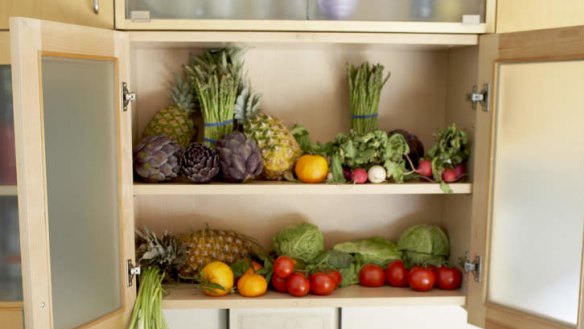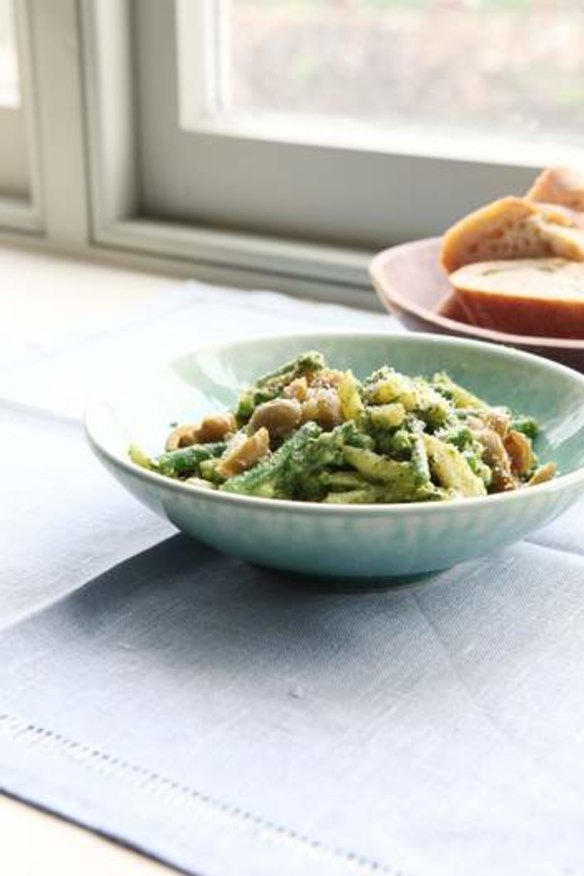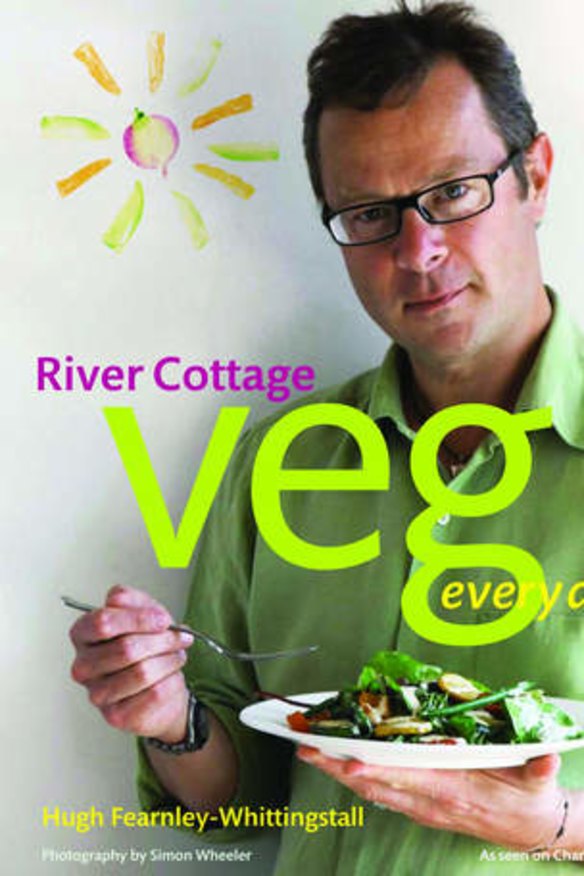A week without meat
A family tries going meat-free for a week in preparation for the nationwide (and official ) Meat Free Week, March 24th-30th.

- Recipe extract River Cottage Veg Everyday!
I should have known I'd be up against it from the moment I walked into my local butcher. They all stood there in their blood-stained aprons, holding very sharp knives, hands on their hips and looks of incredulousness on their faces.
"We almost choked on our lamb chops," they said, or something to that effect, having read that this edition would be a meat-free one. I felt as though I was betraying a lover, particularly given there's a sausage at said butcher's with my name on it.

"It will only be a brief affair," I promised, buying some eye fillet for dinner that night, the night before my family kicked off Meat Free Week.
It was a hard sell at home as well. The boys like their meat. I do, too. Only my daughter, who occasionally dabbles with the idea of vegetarianism, for ethical and taste reasons, and the fact she's almost 13, an age where she dabbles with lots of ideas, was receptive to the whole thing.
Luckily, or so I'm sure he thought, my husband was away for a few nights in the middle of it. The kids are a little more tied to my apron strings when it comes to dinner options. They'd have to eat what I served them.

I tried hard to get everyone excited. The kids and I made a special trip to the farmers' markets on Saturday morning and I let them choose an ingredient we could find a recipe for. We ended up with some pumpkin, some little new potatoes and zucchini at an excellent price. Nothing too out of the ordinary, but the familiar seemed to calm them.
Once home in the kitchen, I turned to what has become my vegetable bible for inspiration - Hugh Fearnley-Whittingstall's River Cottage Veg Everyday!, a fabulous book. The potato rosti recipe is a staple. (They were delicious with that piece of eye fillet.) His roasted tomato sauce is the ideal base for many things. Plenty of salads and sides to serve at barbecues alongside pork chops and lamb cutlets and fillets of fish.
But there are plenty of stand-alone dishes I had been yearning to try. I knew the kids wouldn't balk at a spinach, penne and cheese souffle, pasta with new potatoes, green beans and pesto, macaroni peas. Anything that had pasta and cheese in it would be a winner. And they all were. Leftovers of the pesto dish went into the freezer and made a comeback once the week was over, boosted with some shredded barbecue chicken for a quick midweek meal.
I also used the lure of the barbecue as a selling point. Ross Dobson, one of my favourite cooks when it comes to the grill, has a vegetarian version in his Fired Up series. As well as salads and sides, there is plenty of substantial fare. All filling enough as a meal.
For something different we tried the haloumi, preserved lemon and mint cigars as an afternoon snack on the weekend (Ross Dobson recipe here). Who would have thought filo pastry would taste so delicious on the barbecue? These will be become a drinks party regular.
Was our experiment a success? In a way, yes, but we'll still be eating meat.
As Fearnley-Whittingstall says in the introduction to Veg Everyday!, the aim of the book is "to persuade you to eat more vegetables. Many more vegetables. Perhaps even to make veg the mainstay of your daily cooking."
I don't think vegetables will ever become the mainstay of our cooking, but we're certainly looking at vegetables, the flavours, the combinations and the potential in a completely different way.
Recipes below from: Hugh Fearnley-Whittingstall's River Cottage Veg Everyday! Bloomsbury Publishing, 2011.
Pasta with new potatoes, green beans and pesto
Serves 4
This is a traditional Ligurian pasta dish: substantial but not as heavy as you might think. The green olives are authentic, but you can easily leave them out; I often do.
A decent, ready-made pesto would work here, but the dish is taken to a whole new level if you make your own. I've used a combination of basil and parsley for the pesto but you can use all basil or all parsley if you prefer.
Ingredients
300g new potatoes
300g pasta, such as trofie, orecchiette or penne
200g french or other green beans
50g stoned green olives, roughly sliced or chopped (optional)
For the pesto:
50g pine nuts or walnuts, lightly toasted
one large bunch of basil (about 30g), leaves only
one large bunch of parsley (about 30g), leaves only
a few mint leaves (optional)
1 garlic clove, chopped
50g parmesan, hard goat's cheese or other well-flavoured hard cheese, finely grated
finely grated zest of 1/2 lemon
100-150ml extra-virgin olive oil
good squeeze of lemon juice
sea salt and freshly ground black pepper
To serve:
Extra-virgin olive oil, to trickle (optional)
extra cheese (as above)
Method
First make the pesto: put the toasted nuts into a food processor along with the herbs, garlic, grated cheese and lemon zest. Blitz to a paste, then, with the motor running, slowly pour in the olive oil until you have a thick, sloppy puree. Scrape the pesto into a bowl and season with salt, pepper and a good squeeze of lemon juice. This will keep in the fridge for a few days.
Put a very large pan of well-salted water on to boil. Meanwhile, cut the potatoes into thick matchsticks (the size of thin chips). Add the potatoes and pasta to the pan and cook until the pasta is al dente - probably 10-12 minutes, which should be the right amount of time for the potatoes too. If the pasta is a type that cooks very quickly, put the potatoes in a few minutes before. (If using very freshly dug new spuds, they'll cook quicker, six to seven minutes, so add halfway through the pasta cooking).
In the meantime, cut the beans into lengths that roughly match the size of the pasta. Add them to the pan about four minutes before the end of cooking.
Drain the pasta and vegetables, and let them steam off for a minute or two, then add the pesto and mix thoroughly but gently. Check the seasoning (it will probably benefit from a generous grinding of black pepper).
Divide between warmed serving bowls and scatter over the green olives, if using. Grate over some cheese and trickle over a little extra virgin olive oil if you like. Have extra cheese for grating on the table.
Macaroni peas
Serves 4
Peas and pasta with bacon or ham is a classic combination. In this dish (inspired by a lovely Nigella Lawson risotto recipe), parmesan gives the desired salty-savoury note. Some of the peas remain whole, to give a pleasing, pop-in-the-mouth texture; the rest are blitzed to form a creamy pea sauce.
Ingredients
500g peas (fresh or frozen) or petits pois
300g small macaroni, or smallish pasta shapes such as orecchiette or fusilli, or even risoni
50g butter
1 garlic clove, chopped
25g parmesan, hard goat's cheese or other well-flavoured hard cheese, coarsely grated, plus extra to serve
sea salt and freshly ground black pepper
shredded basil or flat-leaf parsley, to serve (optional)
Method
Put a large pan of well-salted water on to boil, so that you're ready to cook the pasta while the sauce is coming together.
Put the peas in a pan, cover with water, bring to the boil and simmer until tender - just a couple of minutes for frozen or very tender fresh peas, longer for older fresh peas. When the peas are almost cooked, add the pasta to the pan of boiling water and cook until al dente.
Meanwhile, melt the butter in a small pan over a low heat and add the garlic. Let it cook gently for just a couple of minutes, without colouring, then remove from the heat.
Drain the peas, reserving the cooking water. Put about half of them in a blender with six tablespoons of the cooking water, the butter and garlic, and the grated cheese. Blitz to a smooth, loose puree, adding a little more water if needed. Combine with the whole peas and season with salt and pepper to taste.
Drain the pasta as soon as it is ready and toss immediately with the hot pea sauce. Serve topped with plenty of ground black pepper and more grated parmesan. Shredded basil or chopped flat-leaf parsley is a good, but by no means essential, finishing touch.
Courgette and rice filo pie
Serves 4
This is based on an intriguing, delicious Greek dish that I came across in a battered old copy of Mediterranean Vegetable Cookery by Rena Salaman. The rice steals the water from the grated courgettes and plumps up as the two cook together inside the pie. It's as tasty as it is cunning.
Ingredients
500g courgettes, coarsely grated
75g long-grain white rice
1/2 medium red onion, finely chopped
75g hard goat's cheese or mature Cheddar, grated
2 large eggs, lightly beaten
2 tbsp olive oil
one handful of dill, chopped
one good handful of flat-leaf parsley, chopped
250g ready-made filo pastry
75g unsalted butter, melted
sea salt and freshly ground black pepper
Method
Preheat the oven to 190C. Mix the courgettes, rice, onion, cheese, eggs, olive oil and chopped herbs together in a large bowl. Season with plenty of salt and pepper. Take a sheet of filo pastry, brush with a little melted butter and use it to line a smallish ovenproof dish, about 1.5 litre capacity, placing the pastry butter-side-down. Let any excess hang over at the ends. Add another buttered sheet on top and continue until you've used all but one sheet of the pastry.
Tip the filling into the pastry-lined dish. Fold over the pastry ends to enclose the filling, dabbing with a little more melted butter to keep the pastry together. Take the remaining sheet of pastry, crumple it lightly in your hands to give a nicely textured finish and place on top of the pie, tucking in the edges around the side. Dab a little more butter over the surface and bake for 45 minutes until golden. Serve hot or warm.
The best recipes from Australia's leading chefs straight to your inbox.
Sign up